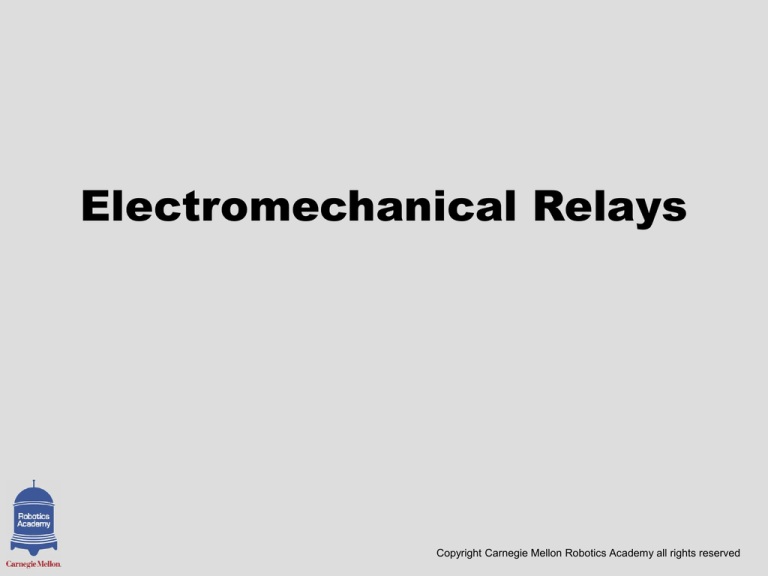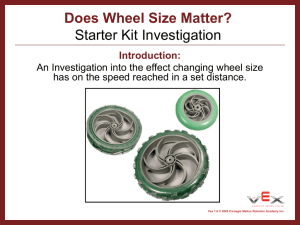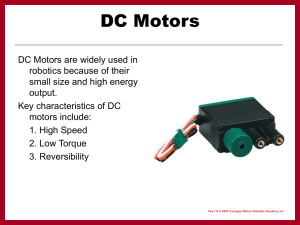
Electromechanical Relays
Copyright Carnegie Mellon Robotics Academy all rights reserved
Objectives
Upon completion of this tutorial the student
will be able to:
• Construct an experimental relay
• Observe basic relay functions
Copyright Carnegie Mellon Robotics Academy all rights reserved
What is the purpose of a
relay?
• A relay is an electromechanical device that
uses small electrical currents and voltages
to control larger electrical currents and
voltages. Relays have unlimited
possibilities ranging from industrial
applications to consumer electronics such
as microwave ovens and television sets.
Copyright Carnegie Mellon Robotics Academy all rights reserved
• In a microwave oven, the push of a few
tiny buttons on the keypad gives
commands to a microcontroller which can
produce only very small output voltages.
Those small voltages turn on a relay which
is capable of controlling the large voltages
and currents required to produce the
heating affect that takes place.
• In a television, the tiny impulses from the
hand-held remote unit controls a relay in
the power supply.
Copyright Carnegie Mellon Robotics Academy all rights reserved
What is the purpose of a
relay?
Homemade Relay
•
A relay is basically a switch that is
controlled by an electromagnet.
Manufactured Relay
• A relay is used when a large current
needs to be turned on or off by a small
current.
• Relays are used in many industrial
applications as well as devices such as
televisions, stereo systems etc.
Copyright Carnegie Mellon Robotics Academy all rights reserved
All electromechanical relays have three basic parts:
1. Electromagnet – consists of an iron core wrapped with turns of insulated wire
2. Armature – this is the moving part of the relay.
3. Switching contacts – at least one must be stationary and one fastened to
the armature. This is known as a single-pole single-throw arrangement.
What is the purpose of a
relay?
•
Armature
A relay is basically a switch that is
Switching
contacts
controlled by an electromagnet.
• A relay is used when a large current
Armature
Switching
needs to be turned
on or off by a small
contacts
current.
• Relays are used in many industrial
applications as well as devices such
as
Electromagnet
televisions, stereo
systems
etc.
Note: In the
manufactured
relay the switching
Electromagnet
contacts are insulated from the armature. Our
experimental relay uses the metal armature and
a 8d common nail
asCarnegie
the switching
contacts
Copyright
Mellon Robotics Academy
all rights reserved
How to build a simple
electromechanical relay
• Materials required:
15’ #22 or #24 ga. Solid
insulated hook-up wire.
2 ea. 8d common nail
1 ea. #8 flat washer
1 small block of wood
(approximately 2” x 3” x ½”)
Sheet metal or plumber’s
strap
1 ea. ½ “ long self-tapping
screw.
• Tools
hammer or drill
screwdriver
metal shears
wire stripper / cutter
Copyright Carnegie Mellon Robotics Academy all rights reserved
How to build a simple
electromechanical relay
• Begin by sliding the #8
washer on to the nail.
• Drill a hole for the nail or
use a hammer to drive
the nail approximately ¾”
– ½” from the edge of the
block.
Copyright Carnegie Mellon Robotics Academy all rights reserved
Part 1 - Winding the
Electromagnet
• Slide the washer to
the head of the nail.
This washer will allow
us to wrap 4 layers of
wire.
• Allow at least 6” of
wire under your left
thumb. Begin by
wrapping the wire in a
clockwise direction.
Copyright Carnegie Mellon Robotics Academy all rights reserved
Part 1 - Winding the
Electromagnet
• Continue winding the wire
to the washer. Be sure to
keep the turns close.
If you have never wound
coils for electromagnets,
try to be patient. Do not
be in a hurry.
Copyright Carnegie Mellon Robotics Academy all rights reserved
Part 1 - Winding the
Electromagnet
• When the windings reach the washer,
continue winding clockwise on top of the
previous layer. Wind toward the wood.
Copyright Carnegie Mellon Robotics Academy all rights reserved
Part 1 - Winding the
Electromagnet
• After you wind the
second layer down to
the wood block, wind
two more layers in the
same manner as the
first two for a total of 4
layers. Be sure to
wind close and tight.
Copyright Carnegie Mellon Robotics Academy all rights reserved
Completed electromagnet
Leave approximately 6” of
wire on both ends.
Twist wires together so that the windings
won’t unravel.
Copyright Carnegie Mellon Robotics Academy all rights reserved
Part - 2- Armature and
Switching Contact
• Drive another 8d
common nail
approximately 1 ½”
from the center of the
electromagnet nail.
Copyright Carnegie Mellon Robotics Academy all rights reserved
Fabricating the Armature
• Cut a length of the
plumber’s strap or
other thin sheet metal
to a length of 6”. If
you are using sheet
metal, be sure that it
is a ferromagnetic
material. (iron based)
Aluminum and copper
will not work.
Copyright Carnegie Mellon Robotics Academy all rights reserved
Fabricating the Armature
• Bend the strap 90°
with pliers as shown
so that it will be
approximately ¼”
above both nail
heads. Use a small
self tapping screw to
attach the strap to the
wood base. Drill a
pilot hole if necessary
3”
Continued on next slide
Copyright Carnegie Mellon Robotics Academy all rights reserved
Adjusting the armature
The armature can be adjusted by trial and error bending.
Copyright Carnegie Mellon Robotics Academy all rights reserved
Build the Relay Circuit
Material List
Strip and connect
to armature screw
Lamp
Negative
battery
Connection
(black)
Schematic
Strip end
of wire.
Wrap
around
nail.
Strip and
splice to +
battery
connection.
(Red)
Switch
1.5 volt
AA cell
Solder or
tape wires
to cell.
• lamp socket
• 6 - 12 volt
lamp
• battery 6-9
or 12 volt
• 24 or 22
gauge hookup
wire.
• AA cell
• Plumber’s
strap , switch
• battery
connector
• self-tapping
screws
Homosote
or Plywood
base.
Copyright Carnegie Mellon Robotics Academy all rights reserved
Schematic Drawing of the Relay
Circuit
Switching contact
(nail)
Armature contact
The controlled
device in this
schematic is a 6 – 9
volt light bulb. You
can use a DC motor
or other device. The
battery can also be
changed to
accommodate the
particular device to
be controlled.
Experimentation is
the key!
This box is the schematic
symbol for the relay
Switch
Electromagnet
-
+
Battery
AA cell 1.5 v
Back to the
finished
project
Copyright Carnegie Mellon Robotics Academy all rights reserved
Movie
Copyright Carnegie Mellon Robotics Academy all rights reserved










